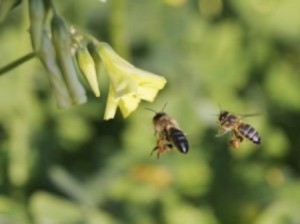 Bees are the honey in any garden! As a pollinator, they offer an essential ingredient for healthy gardens, both flora and vegetable. And they are especially important as primary pollinators of entomophilous plants - plants pollinated by insects, as opposed to wind pollination. In fact, about 30-percent of our diet is the direct result of bee pollination to a flowering fruit tree or vegetable plant.
Bees are the honey in any garden! As a pollinator, they offer an essential ingredient for healthy gardens, both flora and vegetable. And they are especially important as primary pollinators of entomophilous plants - plants pollinated by insects, as opposed to wind pollination. In fact, about 30-percent of our diet is the direct result of bee pollination to a flowering fruit tree or vegetable plant.
There are about 5,000 different bee species in the United States, 2,000 in Canada, and 20,000 species recognized worldwide. Most species are solitary.
Besides free pollinating service, bees add a sedating hum and vibrant color that livens up the whole yard; making it more attractive and inviting. And let's face it they're cute! It would be practical, then, to keep bees around by providing for their basic needs: nutrition, water, safety, and a home of their own.
To attract bees, provide an abundance of the right kinds of blooms. Because plants tend to flower at certain times, it is a good idea to include a variety of flowers in your garden that will bloom at different times of the year.
Bees won't chew up or otherwise harm prize specimens. Instead, they leave a pollination path as they move from one bloom to the next. So it's all right to include special flora varieties in your bee garden for a more striking visual effect. But the main focus of the garden should remain selecting the best "bee-rewarding" plants you can find.
For best results and less maintenance, your garden should consist mainly of native annual and perennial wildflowers, which grow naturally in your region. Bees are especially attracted to blue, purple, and yellow flowers.
Native wildflowers provide bees with the most nutritious pollen and nectar, whereas many hybrid varieties are often all show, offering little or no nectar. Wildflowers also require less care than other imported varieties of flowers; often requiring less water, fertilizer, and pesticides than showy exotics.
When you plant your bee garden, a diverse array of other wildlife will also be attracted to your yard: butterflies, wasps, hummingbirds, and other pollinators that will further benefit your garden. You will want to provide a pesticide-free save haven for them.
On the shallow end of a pond, create an island of sand or small stones that gradually trails into the water, providing bees with a type of beach from which to drink.
A large flat-surfaced stone placed in the center of the birdbath just above water level makes a handy watering hole for bees, as well as a good sunning location for butterflies.
If you absolutely can't avoid using some insecticides, use lest persistent ones that have been proven safer for bees and other pollinators. Follow application instructions on the label carefully. Apply only after dark or when pollinators like bees are safely within their nests.
Few bees can nest in manicured grass lawns. Leave a small patch of bare ground somewhere in or around your bee garden so that bees can establish underground nests.
A dead tree or log will provide invaluable nesting sites for bees. Or, tie a few dead branches together up against a wood fence, your garden shed or other building, to create a "bee hotel."
Commercial bee home kits are also available, and provide a fun and interesting family activity.
By providing pesticide-free safe havens for bees and other pollinators, you collaborate with nature and play a small but vital role in reversing the dramatic pollinator declines that have occurred over the past few years.
Such efforts - magnified across your state and across country - provide a patchwork of floral islands on which our valued pollinators can survive. In return you, and your gardens, get a honey of a deal!
Here are the questions asked by community members. Read on to see the answers provided by the ThriftyFun community.
What role do bees play in flowering plants?
Bees play a fundamental role in pollinating flowering plants. Their activities gathering pollen help to fertilize plants. They fly collecting pollen to all flowers, and by mixing the pistil and stamen's pollen with their feet, the flowers become fertilized.
"Individual bees tend to focus on one kind of flower at a time, which means it is more likely that pollen from one flower will be transferred to another flower of the same species by a particular bee. Many plants require this kind of pollen distribution, known as cross-pollination, in order to produce viable seeds.Jul 5, 2016" nativeplants.msu.edu/
Bees are essential at pollinating plants, resulting in fruit and flowers. If you don't have enough bee activity in the garden, you have to pollinate the plants yourself. Marigolds attract bees, so plant those if you want more.
Check out these photos.
The beautiful passion flower is our Tennessee State Wildflower. We let it grow wild on our homestead in our garden to encourage the bees to come pollinate our plants. I harvest the leaves of the passion flower to make extract which helps promote restful sleep.